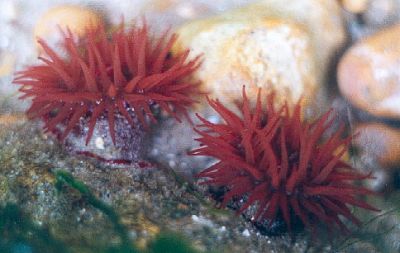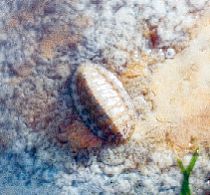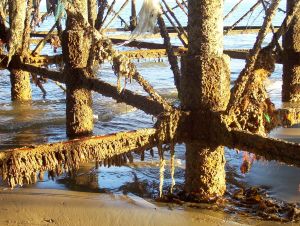Life on Southsea Beach
Southsea beach is mostly shingle, slopes quite rapidly into the sea, is very popular with people and has no obvious rock pools. Perhaps not the best place to look for marine life, but there are a few surprises in store. This page covers living organisms, another page deals with things washed up on the beach.

Piles and Pools
On the beach directly in front of the Royal Naval War Memorial are a series of wooden piles and rails. These are covered at high tide and so attract various marine creatures.
Barnacles and limpets live on the wood, along with the luxurious growth of a seaweed, Toothed or Serrated Wrack. At low tide, there are small pools of sea water alongside the piles. Crabs, Beadlet anemones (pictured left) and Sand Mason worms can be found easily. With luck, Chitons (pictured below right) may be found hiding under larger stones. These small molluscs are articulated like woodlice, but have no legs.

The Castle Rocks
A short way to the east, Southsea Castle is protected from the power of the sea by large boulders. These are stable enough for seaweeds to establish a grip. The seaweeds in turn provide a home for small animals such as crabs and shellfish. These attract Purple Sandpipers, birds which are more usually found on natural rocky shores. They are most likely to be here during the winter, before migrating in Spring to breed in Iceland. High water is not a good time to see them as all the seaweed on the rocks will be covered.

South Parade Pier
A low spring tide reveals an assortment of marine life on the iron framework of the pier. There are orange sponges, and large sea squirts hang down, clothed in other animal life. It seems that the buffering effect of the structure is enough to allow sand to settle out, an unusual sight on Southsea beach. The sand is home to lugworms. In pools around the pillars are groups of Slipper Limpets, stacked one above the other.
Back to Sites


